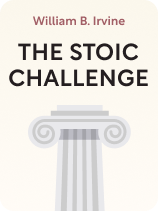

This article is an excerpt from the Shortform book guide to "The Stoic Challenge" by William B. Irvine. Shortform has the world's best summaries and analyses of books you should be reading.
Like this article? Sign up for a free trial here.
Do you know how to practice Stoicism? What is the Stoic strategy for handling adversity?
According to William B. Irvine, the Stoics’ mental technique for facing adversity was simply to reframe the problem. That is, a Stoic would choose to view it as an opportunity to practice his Stoic virtues—resilience, resolve, resourcefulness, courage, and good humor.
Here’s how to implement the Stoics’ strategy for overcoming adversity in daily life.
Train Yourself to Use the Stoic Strategy
We’ll first discuss two methods of training to make it easier to learn how to practice Stoicism. Both training methods involve actively seeking out opportunities to use the Stoic strategy, and they’ll help you develop resolve and resourcefulness.
Expose Yourself to Unpredictable Adversities
Irvine’s first recommendation is to prepare for real-world setbacks by putting yourself in positions that will probably confront you with unpredictable adversities. If they come along, you have the chance to practice handling the situation as a Stoic would—reframe it as a test, diffuse negative emotions, and find a solution. The point of this training is to get used to the unpredictability of troubles and the task of remembering your strategy, since in normal life, you won’t see adversities coming.
To expose yourself to unpredictable adversities, Irvine says that you should find opportunities to challenge yourself. This could be simple and mundane, like riding your bike to work instead of driving (forcing you to navigate unforeseen troubles along the way) or more ambitious, like learning a difficult new skill. Whatever you choose, it shouldn’t take you too far outside your comfort zone. So if you’re someone who, for instance, doesn’t hike, you’d start with a local forest trail rather than a days-long alpine trek.
According to Irvine, building a new skill is the best kind of challenge you can take on because to learn any skill means navigating numerous unforeseen challenges. This is especially true if you pick a skill that relies on capacities you aren’t strong in—for instance, a powerlifter would likely experience more unpredictable adversities in learning childcare skills than he would from switching to CrossFit.
When you start to challenge yourself, Irvine says that you’ll come face to face with an internal instinct to be lazy. While this impulse exists in all of us, he recommends following the Stoic example and exerting control over it. That is, encountering your inner laziness is a signal to bolster your willpower and lean into the challenge rather than retreat from it. By persistently striving past the discomfort and the pull to take it easy, you’ll assert self-dominance and, in the process, amplify your autonomy.
Over time, opting to keep pushing when the going gets tough will develop your resolve—that is, you’ll get grittier. You’ll become more steadfast in the face of tough challenges, and you’ll get in the habit of not letting your inner laziness control your choices.
Seek Out Direct Discomfort
Irvine also recommends that you undergo training that expands your comfort zone. Whereas the challenge-based training above has you seeking possible adversity, this training involves going out of your way to get uncomfortable. In this case, the adversities won’t be unexpected (you’ll train for that as above) but rather intense and challenging.
Irvine explains that actively seeking adversity will expand your comfort zone, empowering you to remain tranquil and even experience delight in a wider range of circumstances. The greater the levels of intensity you can get used to, the better equipped you’ll be to handle intense, real-world adversities. This training has two dimensions: emotional toughening and physical toughening.
Emotional toughening is when you practice facing your fears in order to expand your comfort zone. Irvine recommends that you gradually expose yourself to what you’re afraid of (such as handling dogs) and intensify the challenge over time.
Physical toughening is when you train your body by exposing yourself to increasingly intense physical stressors. Irvine suggests extreme temperature training, physical exercise, dieting and fasting, and endurance training.
Irvine explains that an added benefit of training in these ways is that the Stoics would experience greater pleasure from lesser indulgence. That is, toughening yourself up with Stoic-style training—living in bare, austere conditions and seeking out challenges—has the side effect of making worldly pleasures seem all the more wonderful if they happen to come along.
In contrast, people who constantly indulge grow used to pleasure and thereby lose their ability to enjoy it. They become so physically and emotionally soft that even slight discomfort will seem unbearable. According to Irvine, this implies that in the long run, intentionally seeking and getting used to discomfort reduces it better than avoiding it does.
Approach Key Adversities Like a Stoic
Now that we’ve covered how to train like a Stoic, we’ll pivot to Irvine’s discussion of three key areas of life in which you can apply this training. Namely, we’ll discuss how to approach failure, falls from high places, and death as a Stoic would.
Approach Failure as an Opportunity to Learn
Irvine suggests that you use the Stoics’ method of reframing to improve your relationship to failure. Specifically, he suggests that you reframe failures—which most of us perceive and thereby experience as adverse events—as learning opportunities.
If you never acknowledge your mistakes and failures, Irvine argues, you’ll never learn anything. This is because our failures show us exactly what we did wrong and, in this way, suggest what we need to do differently to improve the next time around. Failure, then, is profoundly useful. In fact, it’s a core ingredient of success. According to Irvine, anyone who achieves anything of note does so not in spite of failure, but because they learn from their failures. This is true of world-class athletes, entrepreneurs who change the world, parents who raise good humans, professional musicians, and anyone else who’s succeeded.
Irvine recommends that to embrace failure, you should break your goals into actionable steps and anticipatable obstacles. Then, take action, make mistakes, learn from them, and push ahead. You’ll either succeed or fall short having learned a lot. And if you fail, don’t worry—it’s better to have tried and failed than to have never tried at all.
Approach the Loss of Good Fortune With Grace and Humility
Next, Irvine turns to what he calls a particularly pernicious form of adversity—when things are going well, you’re high on success and good fortune, and then suddenly everything takes a catastrophic turn.
The Stoics noticed this phenomenon and would practice humility as a way to allay the risk of such catastrophic reversals of fortune. According to Irvine, any extended period of good fortune tends to lead into a particularly brutal or unexpected misfortune. To avoid this, he recommends that you do as the Stoics did: Take good fortune in stride and stay humble. More specifically, enjoy it without announcing your joy to the world. Doing so can attract envy; and envious peers, Irvine says, are the most common source of reversals of fortune. Such people will try to sabotage or ruin your good times, like a workplace colleague who’s jealous of your recent promotion.
Approach Death as the Final Stoic Test
Last, Irvine turns his attention to how the Stoics approached death. He says that today, we typically ignore the reality of death. We sweep it under the rug or operate on naive childhood understandings of death as leading to a happy afterlife. And because we ignore our inevitable deaths, we never realize the true value of our lives.
According to Irvine, the Stoics related to death differently. First, they actively practiced acknowledging human mortality in order to better appreciate their lives in the present. They did this with a variety of techniques that involve briefly thinking about worst-case scenarios. This makes use of the anchoring effect, a psychological phenomenon wherein priming yourself with a reference point helps you see something in a new light. The Stoics’ techniques include:
- Realizing that this could be the last time you’re doing something—be it cooking a meal, hugging your best friend, or sitting down to work.
- Contemplating that someday in the future, you’ll likely wish you could return to this present moment—to an old and enfeebled version of yourself, earlier life could seem a wonderland.
Both of these techniques help you candidly see the reality of your eventual death and thereby appreciate your life more now. This may seem paradoxical, but knowing deeply that you’ll one day die can bring you more fully into living your life today.

———End of Preview———
Like what you just read? Read the rest of the world's best book summary and analysis of William B. Irvine's "The Stoic Challenge" at Shortform.
Here's what you'll find in our full The Stoic Challenge summary:
- How you can minimize suffering by reframing it
- How you can use the Stoics’ strategy in your everyday life
- Why you should take any good fortune in stride






